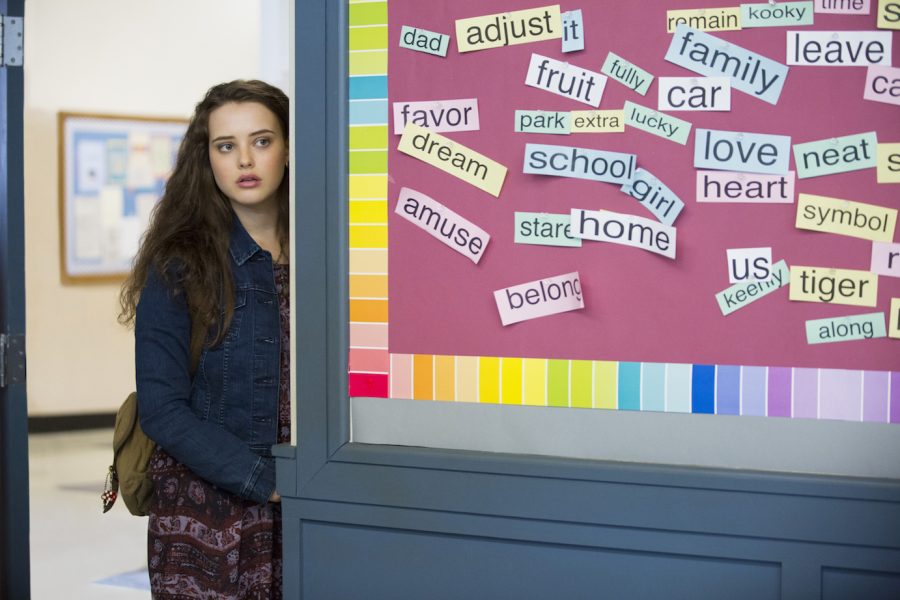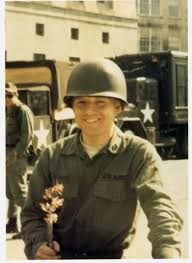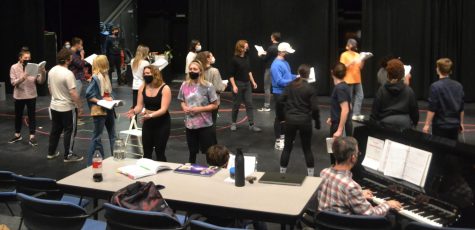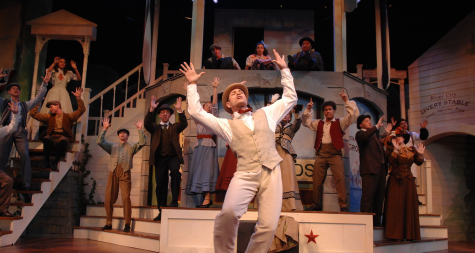Danger in fiction: How Netflix’s ’13 Reasons Why’ raised alarms with a single scene
May 9, 2017
Normally, this is where a spoiler alert would be, but that type of warning would imply that the reader should watch the show at hand.
Some professionals in Kent would urge otherwise when it comes to one of Netflix’s latest binges, “13 Reasons Why,” a teen drama that can’t quite seem to shake its cloud of controversy.
The premise of the series hinges on the tragic story of Hannah Baker, who posthumously explains why she decided to commit suicide via a set of cassette tapes she recorded and sent to her classmates. These 13 people on a chainmail of blame are her “reasons.”
Each episode finds Hannah faced with another hardship, but it’s not the show’s prolonged depictions of sexual assault, bullying or drug abuse that have some viewers outraged — it’s a shocking scene that comes in the finale, a scene that graphically showcases the protagonist’s suicide.
From the moment of contemplation with razor blade in-hand to the distressed screams of a mother with a lifeless daughter in-arms, the sequence is three minutes long. There are no tasteful cutaways or details left to the imagination, and the scene plays out in silence, save for some cutting sound effects and fading last breaths.
Jason McGlothlin is an associate professor in the Department of Lifespan Development and Educational Sciences at Kent State. Shelves in his office are stacked with books, folders and files on suicide accumulated over years of studying prevention, assessment and crisis intervention.
For McGlothlin, the most troubling part about the scene is that it can function as a how-to guide for anyone with suicidal tendencies.
“There are some times where the graphic parts could be educational, but what you don’t want to do is teach teens how to do it the right way,” he says. “That’s just bad juju.”
With a hectic end-of-semester workload, McGlothlin hasn’t yet seen “13 Reasons Why,” but he said he has already set a time to sit down and watch it with his family this summer.
“I feel like I have to watch it,” he says. “I’d rather sit with them and watch it so we can process it to see how they react to it.”
Training future counselors, McGlothlin teaches students how to identify suicidal signs in people and how to build a “therapeutic trust” to be seen as nonthreatening. He feels one good thing the show has conjured is a conversation on suicide.
“Any press is at least good press, to some degree,” he says. “Maybe the intentions of the show were good, but I think it has spun in a way that’s out of control or misperceived.”
Since the 13-episode season was released in its entirety March 31, “13 Reasons Why” has become the most tweeted-about TV show this year.
Popularizing a discussion on the complexities of suicide is also what Barbara Drew, an associate professor of nursing, sees as a positive outcome from the show.
“When it’s stigmatized, people don’t talk about it, and that’s a problem,” she says. “I’m just not sure this show is the way to deal with it.”
Drew, who describes suicide as the “ultimate tragedy,” has spent her career in suicide prevention studying mood disorders in young adults and adolescents. She says the topic can be hard for teens to talk about.
According to the Centers for Disease Control and Prevention, suicide is the third leading cause of death among 10 to 14-year-olds in the U.S. and the second leading in those ages 15 to 34. The American Foundation for Suicide Prevention estimates that 44,193 Americans die by suicide each year, and data gathered by the American Association of Suicidology ranks Ohio at 28 among states with highest suicide rates of those ages 15 to 24.
“Maybe the intentions of the show were good, but I think it has spun in a way that’s out of control or misperceived.” -Jason McGlothlin
While the show brings the conversation to a young adult market, she feels showing Hannah’s suicide was a “bad choice.” Although she has not seen “13 Reasons Why,” Drew has no intentions of adding the show to her Netflix queue anytime soon. “For entertainment, I will typically not watch a show like that,” she says. “It’s a very sad thing. It’s too much like work for me.”
That sentiment is shared by Jason Hedges, school psychologist at Theodore Roosevelt High School in Kent. “To me, there’s enough horror in the real world, we don’t need the fictionalized garbage,” says Hedges, who has worked with adolescents as a counselor for about 15 years.
He describes his role as an “educational investigator,” testing students to get to the root of why they aren’t functioning socially or emotionally in school. Aside from that, he fields drop-ins from students who want to discuss relationship issues and problems at home. “I think there is a lot of demand,” he says. “It’s not that I can’t handle it, it’s just always a juggling act of making sure all my paperwork is done, but also — more importantly — that kids’ needs are being met.”
Hedges can’t count how many cases of students battling depression and threatening to end their lives he’s handled over the years. “Every year I’ve got a pocketful of kids that just need someone to help put things in perspective, and those are just the ones brought to my attention,” he says.
The first step Hedges takes after listening to a suicidal student is to call the parents, who he thinks should intervene.
As a mentor to teens, Hedges is loaded with catchy one-liners to reach young minds: “Either you’re going to let them get the best of you, or you’re going to make the best of it,” “Suicide is a permanent solution to a temporary problem.” His life experiences give his pleas against suicide weight; more than 20 years ago, his brother killed himself.
“Every one of us goes through something in life,” he says. “Part of being a strong person is being able to persevere and not let other people dictate the outcome of your life.”
His problem with “13 Reasons Why” is a problem he has with a lot of Hollywood projects. In fact, Hedges doesn’t watch TV and hasn’t for years because of the way he feels the entertainment industry “glamorizes everything that’s so dark instead of providing reasonable solutions to problems.”
“I think it is kind of morbid,” he says about the show. “I think I would like it better if she didn’t commit suicide, and here are all the reasons why.”
Several Ohio school districts have taken stances against “13 Reasons Why,” telling parents to remain cautious. In a letter sent home to parents in New Albany-Plain Local School District, middle school counselors lay out their concerns, saying, “Our fear is that this series could be giving our children mixed messages about the appropriate ways to help a friend.” The Strongsville superintendent also issued a warning to parents, suggesting they have conversations with their children about mental illness.
Forbidding against watching the show is not going to stop students from seeking it out, Hedges understands. Instead, he suggests thinking critically while binge-watching.
“If you are watching something passively, that’s kind of a problem,” he says. “I would say watch it with a highly critical lens. I just think it’s a shame that there is so much of this.”
Hedges first heard of “13 Reasons Why” when a student brought the novel the show is based on to him. First published in 2007, the YA best-seller written by Jay Asher sparked a fan base that renewed with each new crop of teenage readers leading up to the debut of the series 10 years later.
Several English teachers at Roosevelt High School use the book in their lesson plans. Jeff Harr is of that group and offers “13 Reasons Why” on a list of titles for his students to choose from.
“We’re not afraid to give kids books that are about topics that are going to be important to helping them emotionally or mentally,” he says. “I’m always thinking as a teacher when I read something, like, you know, ‘This’ll be good for kids.’”
Aside from its themes, the book is used by Harr to discuss literary devices, structure, plot and author techniques with his juniors and seniors.
While he is a supporter of the book, Harr’s views on the Netflix adaptation do not align with his thoughts on the source material. He argues that most of the 288-page book’s subtleties are lost in the series’ 13 hours when more focus is taken away from the core of the story. He sees the true message of the book as an indictment of bystanders, urging readers to be considerate and open to those in need. The show, he feels, becomes all about the suicide.
“I mean, it is hardcore,” Harr says about the shocking scene, which was hard for him to watch. “I think (showing the suicide) is cheap. In the book, it’s much more subtle, and you’re not confronted with it.”
Much of the narrative was amped up in its transition from page to screen. Not only were more storylines added to flesh out perspectives, but the way Hannah kills herself is heightened for visual impact, trading a handful of pills for bloody wrist incisions.
In describing the series, Harr used the word “dark” four times in three sentences, and said the gritty drama of it appeals to young adults.
“They love that kind of stuff,” he says. “Not in a sick way, but they are drawn to it.” While he’s not against realistically portraying issues on screen, he was turned off by the way the show “sensationalized” and went “over the top” during certain scenes, from his point of view.
But, if the series inspires more audiences to read the book, Harr says he’s satisfied. “I don’t buy into the idea that if you give them a book about suicide, they’re going to want to commit suicide,” he says. “A lot of books for teens, this is just their world; they’re dealing with these issues, and they have to read about them.”
If you are thinking about suicide, call the National Suicide Prevention Lifeline at 1-800-273-8255 or the Suicide Crisis Line at 1-800-784-2433. For help on campus, call Psychological Services at 330-672-2487, or the University Health Services 24-hour Nurse Line at 330-672-2326. For more local resources, call the Townhall II Helpline at 330-678-HELP.
Editor’s note: Benjamin VanHoose is the Fall 2017 editor-in-chief of The Burr Magazine, one of Kent State’s student magazines. Contact him at [email protected]. See more of the magazine’s content here.
This story is part of a student media project entitled “The Silent Struggle.” See the whole project here.


























